
|
Movie music is the fast food of cinema. It serves the purpose of filling an immediate need but ultimately is neither satisfying nor memorable and can dull an appetite for the real thing. Indeed, typical film scores tend to be lengthy stretches of vapid functional mood music without lasting value (or, more recently, random assortments of existing pop records). Of the rare exceptions, Sergei Prokofiev's 1938 score to Alexander Nevsky often is hailed as the foremost example of a movie score of indisputable distinction.
![]() Music has always been an integral part of the movies.
Music has always been an integral part of the movies.
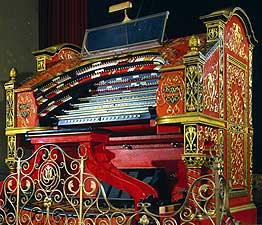 Wurlitzer organ console – Alabama Theatre |
![]() Sergei Eisenstein (1898 – 1948) occupies a unique niche in film history – not only one of the most influential directors (although he completed only six features) but the foremost theorist, although the latter is far less an honor than it might seem, as nearly all that passes for film theory is little more than a diffuse set of anecdotal ramblings of personal preference rather than a meaningful attempt at a unified practical model of universal artistic application.
Sergei Eisenstein (1898 – 1948) occupies a unique niche in film history – not only one of the most influential directors (although he completed only six features) but the foremost theorist, although the latter is far less an honor than it might seem, as nearly all that passes for film theory is little more than a diffuse set of anecdotal ramblings of personal preference rather than a meaningful attempt at a unified practical model of universal artistic application.
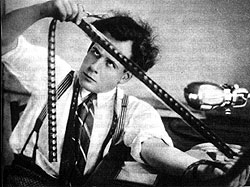 Sergei Eisenstein |
Lev Kuleshov and Vsevolod Pudovkin had used editing not only to extend but to invent meaning absent in individual shots, exploiting the fact that we naturally tend to associate adjacent images and link them with narrative significance. Thus, in one of their famous experiments an actor pointing off-screen followed by an unrelated shot of nearly anything created a sense that he was looking at the object shown in the second shot even if it had no actual connection and could even be located on another continent. In a second experiment the same expressionless shot of an actor's face was inserted into sad and happy scenes, leading audiences to praise his huge variety of expressive acting. But all of that was functional. Eisenstein went further to expand editing into the realm of metaphor. His first movie, Strike (1924), is one of the most brilliant debuts in cinema history, insistent in its sustained energy and full of bold compositions, extreme close-ups, optical devices, camera movement, brisk editing and snide titles that not only reflect the thrill of discovery but evidence a thorough grasp of film technique and a resolute dedication to its sociopolitical core. Eisenstein's editing further reflected a basic principle of Marxism – that a collision between two opposing ideas (here, a cut between two shots) is resolved in a synthesis of greater meaning. Thus Strike concludes by intercutting scenes of a bull being slaughtered with workers being massacred by a factory owner's militia, asserting direct thematic equivalence and giving rise to feelings of outrage and, presumably, a commitment to social action.
 Potemkin – The three stone lions |
Eisenstein directed two more silent features. October – Ten Days That Shook the World (1928) celebrated the tenth anniversary of the 1917 revolution and used inserted shots to comment on events and personalities, such as a preening peacock to mock the vanity of Kerensky (a revolutionary socialist leader whom Lenin had overthrown) and repeated shots of him climbing the same lavish staircase to satirize his endless ambition. The General Line (also known as Old and New, 1929) traced the rise of collectivized agriculture and, reflecting its rural setting, focused more on complementary shots that Eisenstein felt had "tonal" resonance. Both movies were condemned by Soviet leaders as too "formalistic," meaning that they relied too much on showy technique. Eisenstein's career then went into eclipse. Aborted projects during years abroad prompted Soviet attacks for having pro-Western leanings. Alexander Nevsky promised to provide a vehicle for homecoming and redemption.
![]() Eisenstein seized upon Alexander Nevsky as a timely subject bound to please the Soviet bureaucrats. James Goodwin notes that Lenin had viewed Russian history in terms of class struggle and thus ignored individual roles and hardships – indeed, although canonized in 1574 Nevsky wasn't even mentioned in official texts of Lenin's time. Stalin, though, saw himself as the spiritual heir of past leaders (in part to justify his own megalomania) and, as Harlow Robinson notes, elevated Nevsky to a hero's status as a fair, god-fearing statesman. Even more important as the Nazi threat loomed, in 1242 Nevsky had mustered a peasant army to defeat Teutonic invaders and thereby saved Russia from being overrun by German forebears. (Goodwin contends that in reality Nevsky then capitulated, appeased and allied with the Mongols.) Writing in 1939, Eisenstein revered the Nevsky of legend as "the first shoot of national consciousness engendered by Teutonic aggression." (Eschewing any subtlety, he further proclaimed Stalin "the greatest strategist in world history.") Jay Leyda finds in the Nevsky tale the quality of a fable, showing the way to face a critical modern situation through a crisis and victory of the past. The propaganda value of a Nevsky film seemed irresistible.
Eisenstein seized upon Alexander Nevsky as a timely subject bound to please the Soviet bureaucrats. James Goodwin notes that Lenin had viewed Russian history in terms of class struggle and thus ignored individual roles and hardships – indeed, although canonized in 1574 Nevsky wasn't even mentioned in official texts of Lenin's time. Stalin, though, saw himself as the spiritual heir of past leaders (in part to justify his own megalomania) and, as Harlow Robinson notes, elevated Nevsky to a hero's status as a fair, god-fearing statesman. Even more important as the Nazi threat loomed, in 1242 Nevsky had mustered a peasant army to defeat Teutonic invaders and thereby saved Russia from being overrun by German forebears. (Goodwin contends that in reality Nevsky then capitulated, appeased and allied with the Mongols.) Writing in 1939, Eisenstein revered the Nevsky of legend as "the first shoot of national consciousness engendered by Teutonic aggression." (Eschewing any subtlety, he further proclaimed Stalin "the greatest strategist in world history.") Jay Leyda finds in the Nevsky tale the quality of a fable, showing the way to face a critical modern situation through a crisis and victory of the past. The propaganda value of a Nevsky film seemed irresistible.
Eisenstein was also eager to make his first sound film. Years behind the West, as late as 1933 over half of new Russian movies were still silent. In the meantime, Einstein's theories rejected literal connections between image and sound, especially dismissed dialog as redundant and a waste of resources, and instead looked to the power of music, sound effects and even silence to enhance dramatic impact.
 Sergei Prokofiev |
![]() His artistic soul-mate for this venture was Sergei Prokofiev (1891 – 1953), with whom he shared not only a name but parallel careers. Prokofiev was a revolutionary long before the Revolution. His early compositions were cold, dissonant and percussive – "a slashing attack on musical Romanticism" (Schonberg). Perhaps fearing an unbridgeable gap between his progressive leanings and the leadership's proletarian cultural demands, Prokofiev left Russia in 1917 and spent 15 years in the U.S. and Paris where his style mellowed considerably. Yet much of even his serious music retained an edge of wry humor, comparable to Eisenstein's start in provocative and farcical theater presentations that owed more to circuses and music halls than the legitimate stage. Like Eisenstein, his output as a émigré was deprecated at home. Both wrapped up their Western sojourns in Hollywood, where they were enthralled by the advanced technology and drawn to its artistic possibilities.
His artistic soul-mate for this venture was Sergei Prokofiev (1891 – 1953), with whom he shared not only a name but parallel careers. Prokofiev was a revolutionary long before the Revolution. His early compositions were cold, dissonant and percussive – "a slashing attack on musical Romanticism" (Schonberg). Perhaps fearing an unbridgeable gap between his progressive leanings and the leadership's proletarian cultural demands, Prokofiev left Russia in 1917 and spent 15 years in the U.S. and Paris where his style mellowed considerably. Yet much of even his serious music retained an edge of wry humor, comparable to Eisenstein's start in provocative and farcical theater presentations that owed more to circuses and music halls than the legitimate stage. Like Eisenstein, his output as a émigré was deprecated at home. Both wrapped up their Western sojourns in Hollywood, where they were enthralled by the advanced technology and drawn to its artistic possibilities.
Prokofiev's first project upon his return to Russia was music for Lieutenant Kije, a wickedly deadpan 1934 satire on the bureaucracy, vanity and social pretension of czarist rule, directed by Alexander Feinzimmer from a story and script by Yuri Tynyanov. The title character is pure fiction, an error written by a nervous clerk in a regimental order to which no one in the czar's retinue dares admit. At first conveniently blamed and exiled to Siberia for the offense of having shouted in the castle and awakening the czar, Kije is recalled, promoted and selected to marry the princess – all in absentia – and, when the czar finally demands to meet this great hero, is reported to have died on his wedding night. Alas, during his lavish state funeral Kije is demoted and stripped of regalia, having been blamed for looting the royal treasury by a thieving count to whose new wealth Kije's "widow" gladly transfers her affection. At the very end, a herald proclaims, partly metaphorically, "The emperor is asleep."
Prokofiev's music – his first film score – is an integral part of the movie, although it is only heard in scraps amid rather crudely rendered dialog and sound effects.
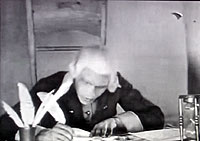 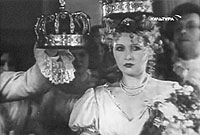 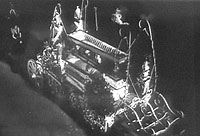 Kije's birth, wedding and funeral |
- Birth of Kije – The first section consists of a fanfare and a rather wan martial piccolo theme heard at key moments throughout Kije's "career," including the labored writing of his actual "birth" – fully apposite since Kije is a creation of an army clerk. Even before that, it underscores a facetious opening montage of rhythmically-intercut shots of military training maneuvers and servants polishing the castle, as if to aptly suggest that Kije was conceived out of the rigor of the czar's imposition of artificial order on human society.
- Romance – In the movie this appears as a harpist's love song to entertain the princess as she idly plays cards and considers suitors. Prokofiev assigns the melody to a lumbering bassoon so as to paint a sonic portrait of an awkward courtship and a highly unsuitable match for royalty.
- Kije's Wedding – The wedding ceremony is a dour formality, accompanied by prayers and vows rigidly chanted by priests to the oppressive throb of a military drum corps. Kije, of course, is not there but the guests, afraid to doubt their leader's wisdom, play their accustomed roles anyway. The music, too, bypasses him, combining a pompous recessional with the mystified bride's pantomimed preparations for her wedding night (in which the drunken count steals her dowry and beds her in place of her imaginary spouse).
- Troika – A drinking song in the movie ("Like a roadside inn is a woman's heart"), this is lustily sung at a tavern and again, spiced by sleigh bells, as a thoroughly soused regiment rides back home. A sustained outburst of joy in its instrumental form, it's the only part of the suite to project genuine feeling rather than the pervasive irony that tints the rest.
- Kije's Burial – Following the movie's mock-solemn funeral march, the final movement recalls highlights of the hero's brief but eventful life (as would be expected in a funeral oration) through quotation of the prior pieces before ending with the opening fanfare – highly apt, as Kije's end was fabricated from the same fleeting and fictitious stuff as his beginning.
The Kije suite is so disarmingly direct that it needs scant interpretation. Through a miracle of control, balance and subtle expression Fritz Reiner and the Chicago Symphony somehow manage to project just the right undercurrent of dry ironic wit in their 1957 RCA recording. Claudio Abbado, also with the Chicago Symphony (DG, 1977), takes a different tack by injecting abundant swagger and energy as if to suggest that Kije indeed was a hero with genuine exploits and feelings, as oblivious to the underlying joke as were Kije's superiors. Beginning with the first recording by Serge Koussevitzky and the Boston Symphony (Victor 78s, 1937; Pearl CD) most others take a middle ground by playing the score as pure music, crisp, clean and straight, letting us read into it whatever we want.
![]() Upon obtaining approval, Eisenstein opted to proceed to shoot his patriotic epic without delay rather than await the next winter to film the central battle on a real ice-bound lake. Instead, he staged it in the heat of summer using glass, white sand and chalk on asphalt. To ensure that he did not repeat the formalistic "mistakes" of his past productions, the State Mosfilm studio surrounded him with advisors who instructed him to aim at the widest possible audience (and cast in the lead role Nikolai Cherkasov, a prominent Party member who sat on the Supreme Soviet). In a bow to contemporary relevance, Mervyn Cooke notes that the invaders' costumes and heraldry were modeled after those of Nazi storm troopers.
Upon obtaining approval, Eisenstein opted to proceed to shoot his patriotic epic without delay rather than await the next winter to film the central battle on a real ice-bound lake. Instead, he staged it in the heat of summer using glass, white sand and chalk on asphalt. To ensure that he did not repeat the formalistic "mistakes" of his past productions, the State Mosfilm studio surrounded him with advisors who instructed him to aim at the widest possible audience (and cast in the lead role Nikolai Cherkasov, a prominent Party member who sat on the Supreme Soviet). In a bow to contemporary relevance, Mervyn Cooke notes that the invaders' costumes and heraldry were modeled after those of Nazi storm troopers.
Eisenstein felt a spiritual bond with Prokofiev, calling him a magician who went beyond illustration, creating the musical equivalent of the visuals by contriving to discover the logic and inner image of a composition, and capturing the emotional meaning of events by grasping the structural secret that conveys broad meaning. Edward Cole hails their work as a true collaboration unique in movie history, mutually provocative, in which visuals and music are not merely complementary but a single interrelated, interlocking whole. Indeed, so closely did they work that for some sequences Prokofiev wrote music based on a rough cut of the images, while for others Eisenstein assembled his shots after hearing a sketch of the music. At first, Prokofiev had toyed with the idea of using the idioms of genuine 13th century music but decided that it "had become alien to us and could not have nourished the spectators' imagination."
Nevsky was completed in a mere five months – half the allotted schedule. In an incident worthy of Lt. Kije, Stalin suddenly demanded to preview the movie, but the version that was hurriedly assembled omitted a reel in progress; as Goodwin recounts, "after Stalin expressed his delight, no one dared inform him that the film he approved was incomplete" and so it was released in that form, and the missing portion was never recovered. Following its premiere showing on December 1, 1938 the movie was a huge success, both domestically and abroad. In August 1939 Stalin signed a non-aggression pact with Hitler and the film was withdrawn, only to emerge with even greater import following Nazi abrogation of the treaty and invasion of Russia in June 1941. (The Nazis eventually would be repelled by the same fatal mix of patriotic sacrifice and punishing winter climate that had led to Nevsky's victory over their ancestors seven centuries earlier – an ironic instance of history repeating itself or, perhaps, life imitating art insofar as the events were depicted in the movie.)
![]() Within two months of the premiere Prokofiev adapted his Nevsky score into a concert cantata, in which form it is nearly always heard nowadays. The seven sections follow the chronology of the movie. [Descriptions of non-musical segments are offset with brackets.]
Within two months of the premiere Prokofiev adapted his Nevsky score into a concert cantata, in which form it is nearly always heard nowadays. The seven sections follow the chronology of the movie. [Descriptions of non-musical segments are offset with brackets.]
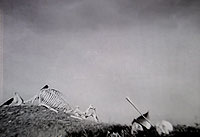 with a heroic overture but Prokofiev prevailed with a far more atmospheric opening. The credit cards (white Cyrillic block letters on a black background) are seen in silence. Then after titles to establish the historical background the first sequence begins, comprising a mere five shots. Eisenstein described it as: "the woeful traces of the ravages wrought by the Monguls – heaps of human bones, swords, rusty lances, fields overgrown with weed and ruins of burned villages." The music, all unrelentingly in c-minor, reflects the desolation of the images – a static initial phrase that repeatedly fails to rise, followed by a mournful rustic wind theme that suggests the continuity of the most basic human activity, albeit far removed. The filmed sequence is barely a minute long; the cantata repeats the opening and an abbreviated wind phrase and then descends to a lingering c-minor chord – an appropriate expansion, as in the cantata the music alone must "set the scene."
with a heroic overture but Prokofiev prevailed with a far more atmospheric opening. The credit cards (white Cyrillic block letters on a black background) are seen in silence. Then after titles to establish the historical background the first sequence begins, comprising a mere five shots. Eisenstein described it as: "the woeful traces of the ravages wrought by the Monguls – heaps of human bones, swords, rusty lances, fields overgrown with weed and ruins of burned villages." The music, all unrelentingly in c-minor, reflects the desolation of the images – a static initial phrase that repeatedly fails to rise, followed by a mournful rustic wind theme that suggests the continuity of the most basic human activity, albeit far removed. The filmed sequence is barely a minute long; the cantata repeats the opening and an abbreviated wind phrase and then descends to a lingering c-minor chord – an appropriate expansion, as in the cantata the music alone must "set the scene."
 as with all five of the choral sections the song here is not shown being performed on-screen but rather is embedded in the musical element as thematic commentary. The text boasts of the triumphant rout of Swedish army invaders on the River Neva and concludes (in Russian, of course, but here in the translation included in the published score): "We shall never yield native Russian land, / They who march on Russia shall be put to death! / Rise against the foe, Russian land, arise; / Rise to arms, great Novgorod!" Yet remarkably, the militaristic lyrics – and especially the menacing end – are mostly set to a gentle, lyric hymn (marked lento), only twice briefly erupting into a more forceful più mosso section, thus dwelling upon the thoughtful, humble side of Alexander's character. [While the eschewing of actual singing might be taken as a manifestation of Eisenstein's creed of asynchronous sound, the movie does contain segments of dialog; here, the song (without the second uptempo section) is split in two by a sequence in which Alexander, interrupted from fishing by a troupe of armed Mongols, diplomatically appeases them and then counsels an elder that a closer, more dangerous foe must first be crushed – the Germans.]
as with all five of the choral sections the song here is not shown being performed on-screen but rather is embedded in the musical element as thematic commentary. The text boasts of the triumphant rout of Swedish army invaders on the River Neva and concludes (in Russian, of course, but here in the translation included in the published score): "We shall never yield native Russian land, / They who march on Russia shall be put to death! / Rise against the foe, Russian land, arise; / Rise to arms, great Novgorod!" Yet remarkably, the militaristic lyrics – and especially the menacing end – are mostly set to a gentle, lyric hymn (marked lento), only twice briefly erupting into a more forceful più mosso section, thus dwelling upon the thoughtful, humble side of Alexander's character. [While the eschewing of actual singing might be taken as a manifestation of Eisenstein's creed of asynchronous sound, the movie does contain segments of dialog; here, the song (without the second uptempo section) is split in two by a sequence in which Alexander, interrupted from fishing by a troupe of armed Mongols, diplomatically appeases them and then counsels an elder that a closer, more dangerous foe must first be crushed – the Germans.]
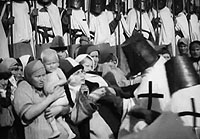 a girl who vows to marry the braver one. Amid vibrant trade, the inhabitants debate capitulation or resistance to invaders. They resolve to summon Nevsky to lead them.] In vanquished Pskov, Teutonic captors boast of their cruelty, toss babies into a fire and hang local leaders who vow revenge. Grievously bitter musical segments underline the opening destruction and the scenes of mayhem. Here the lyricist (Vladimir Lugovskoy) played a nasty trick: to evoke the German army, the chorus obsessively sings a Latin couplet that has an engaging sound and meter for a musical setting: "Peregrinus expectavi pedes meos in cymbalis est." Alas, it means: "A foreigner, I expect my feet to be shod with cymbals!" Prokofiev matches the four-square rhythm of the nonsense text with boring repetition (occasionally thrown off-kilter by injecting odd measures of three) and an accompaniment of "heavy, cruel-sounding chords" in a "clever combination of Gregorian cadences, crushing modern harmonies and brass fanfares" to yield an impression of grim fanaticism (Atfelder) and hypocritical righteousness (Downes). The sinister musical effect is enforced on screen by arraying the Teutons in rigid formations and dressing them in identical armaments with eye slits that deny their individuality, whereas the Russian forces move more naturally and wear a variety of armor with uncovered faces. [At work on his fishing nets, Nevsky receives the envoys but vows to attack the Germans with a peasant army rather than merely defend Novgorod.]
a girl who vows to marry the braver one. Amid vibrant trade, the inhabitants debate capitulation or resistance to invaders. They resolve to summon Nevsky to lead them.] In vanquished Pskov, Teutonic captors boast of their cruelty, toss babies into a fire and hang local leaders who vow revenge. Grievously bitter musical segments underline the opening destruction and the scenes of mayhem. Here the lyricist (Vladimir Lugovskoy) played a nasty trick: to evoke the German army, the chorus obsessively sings a Latin couplet that has an engaging sound and meter for a musical setting: "Peregrinus expectavi pedes meos in cymbalis est." Alas, it means: "A foreigner, I expect my feet to be shod with cymbals!" Prokofiev matches the four-square rhythm of the nonsense text with boring repetition (occasionally thrown off-kilter by injecting odd measures of three) and an accompaniment of "heavy, cruel-sounding chords" in a "clever combination of Gregorian cadences, crushing modern harmonies and brass fanfares" to yield an impression of grim fanaticism (Atfelder) and hypocritical righteousness (Downes). The sinister musical effect is enforced on screen by arraying the Teutons in rigid formations and dressing them in identical armaments with eye slits that deny their individuality, whereas the Russian forces move more naturally and wear a variety of armor with uncovered faces. [At work on his fishing nets, Nevsky receives the envoys but vows to attack the Germans with a peasant army rather than merely defend Novgorod.]
 sung over scenes of humbly-garbed peasants with rudimentary clubs and spears enlisting as they are rallied by leaders. The rousing lyrics ("Arise to arms, ye Russian folk, / in battle just, in the fight to death; / arise, ye people free and brave, / defend our fair native land!") end with a warning: "No foreign troops shall raid Russia." Downes views the music as a fusion of Russian folk song with the epic style of 19th century Russian opera, while Paul Gammond traces the primary motif to the "yo-ho-heave-ho" of Volga boatmen. In marked contrast to the cynical German hymn, the Russian song is full of buoyant hope and confidence. [In the movie, after scenes of Alexander's troops entering Novgorod over an orchestral arrangement of the "Song About Alexander," the song is repeated, both sung and orchestrated, as the residents choose armor. In contrast, in the invaders' camp, a droning organ accompanies a grim religious service for the precisely-arrayed troops. Alexander and his commanders plan their strategy to entrap the German wedge formation between side forces and to lure their horses and heavy equipment to the weak, slippery ice at the edge of a frozen lake.]
sung over scenes of humbly-garbed peasants with rudimentary clubs and spears enlisting as they are rallied by leaders. The rousing lyrics ("Arise to arms, ye Russian folk, / in battle just, in the fight to death; / arise, ye people free and brave, / defend our fair native land!") end with a warning: "No foreign troops shall raid Russia." Downes views the music as a fusion of Russian folk song with the epic style of 19th century Russian opera, while Paul Gammond traces the primary motif to the "yo-ho-heave-ho" of Volga boatmen. In marked contrast to the cynical German hymn, the Russian song is full of buoyant hope and confidence. [In the movie, after scenes of Alexander's troops entering Novgorod over an orchestral arrangement of the "Song About Alexander," the song is repeated, both sung and orchestrated, as the residents choose armor. In contrast, in the invaders' camp, a droning organ accompanies a grim religious service for the precisely-arrayed troops. Alexander and his commanders plan their strategy to entrap the German wedge formation between side forces and to lure their horses and heavy equipment to the weak, slippery ice at the edge of a frozen lake.]
 In lieu of attempting a lengthy description, we can defer to Eisenstein, who published a 40-page analysis purporting to demonstrate the intimate relationship between image and sound in the first dozen shots. (Eisenstein conceded that he chose this portion because the shots are all static and that scenes containing motion would complicate matters.) Shown at the right is the first portion of a chart he presented to depict linkage among the tonality and phrasing of the music, the composition of the images and the eye movements they are intended to prompt. For example, he suggests that the rising bass eighth notes in the second measure correspond to our looking from lower left to upper right of the first frame, whereas the level eighth notes of the eighth measure relate to scanning the bottom of the entire fourth frame as a whole and picking out the three tiny men along the distant horizon.
In lieu of attempting a lengthy description, we can defer to Eisenstein, who published a 40-page analysis purporting to demonstrate the intimate relationship between image and sound in the first dozen shots. (Eisenstein conceded that he chose this portion because the shots are all static and that scenes containing motion would complicate matters.) Shown at the right is the first portion of a chart he presented to depict linkage among the tonality and phrasing of the music, the composition of the images and the eye movements they are intended to prompt. For example, he suggests that the rising bass eighth notes in the second measure correspond to our looking from lower left to upper right of the first frame, whereas the level eighth notes of the eighth measure relate to scanning the bottom of the entire fourth frame as a whole and picking out the three tiny men along the distant horizon.
In 2014 Tim J. Smith undertook to test Eisenstein's approach by tracking eye movements of viewers of the sequence with or without the music and found no significant difference. He notes, of course, that instrumental music can be highly effective in creating or reinforcing an overall mood, as opposed to specific meaning – thus, a rising line can create expectation or shifting tonality can suggest instability. Rather, he notes, it is the content of any shot that directs our attention – a face engages us while a long, static shot encourages our visual interest to wander. Going back to Eisenstein's example, in the third frame it seems reasonable that our eyes would first dwell on the people in the lower left and then trace the rising arc of cloud, and in the fifth frame that we would first explore the people at the left, then check the horizon and observe the sky.
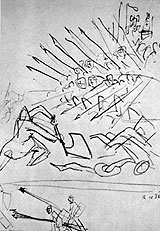 Eisenstein sketch |
In any event, Prokofiev's music keeps pace with the unfolding action, as the German and Russian themes clash and vie for dominance. Even before the actual engagement, in the segment used in Eisenstein's analysis the mood is set by edgy trembling strings as dawn mists envelop the lake. A sinister growing ostinato chugging figure (à la Jaws) then signals the distant approach of the Teutons (Cole). A curious touch – the rout is invigorated by a surprisingly light-hearted but exhilarating piccolo theme – Goodwin calls it "chase" music that would seem comic in another context but perhaps is intended here as satiric. The only literal effect is heard at the end – when the Germans are dragged down by their heavy armor and fall through the thin ice their theme degenerates into a mocking descending trombone glissando. More subtle is deliberate harmonic distortion that makes the German theme sound grating by blowing the brass right into the rear of the recording microphone. For the cantata, Prokofiev condensed and wove the musical fragments of the soundtrack into an unbroken progression while omitting the fanfares and the ice-breaking percussion that are highly effective and make full sense in the context of the battle but carry little significance and would seem trite in isolation. Even so, the sustained volume and intensity of the lengthy central section can be wearying in the concert hall or on record without the visuals to add a level of narrative interest and import. Yet it does suggest the ferocious turmoil and confusion of medieval warfare and enables us to share the sense of relief provided by a string elegy that lingers in the cantata after the battle subsides but is absent from the film, which instead proceeds directly to:
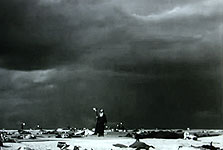 concludes comes this deeply moving funereal tribute to the fallen as the camera pans the carnage, women search among the dead and the wounded try to rise and stagger back to a semblance of life. A solo mezzo-soprano sings of the eternal nobility of the dead and pledges to not wed a handsome man whose earthly beauty will fade but a warrior whose bravery will be timeless. [In the movie, the impact is compromised by sporadic cries of the wounded that overwhelm and add a literal dimension to the music, and by focusing on Olga who finds both her suitors battered but alive.] In its pure concert presentation this piece lingers in memory as an honest and realistic gesture – as Cole notes, no triumphant chord of victory should be struck until the losses of the battlefield are surveyed, as would be done after an actual conflict.
concludes comes this deeply moving funereal tribute to the fallen as the camera pans the carnage, women search among the dead and the wounded try to rise and stagger back to a semblance of life. A solo mezzo-soprano sings of the eternal nobility of the dead and pledges to not wed a handsome man whose earthly beauty will fade but a warrior whose bravery will be timeless. [In the movie, the impact is compromised by sporadic cries of the wounded that overwhelm and add a literal dimension to the music, and by focusing on Olga who finds both her suitors battered but alive.] In its pure concert presentation this piece lingers in memory as an honest and realistic gesture – as Cole notes, no triumphant chord of victory should be struck until the losses of the battlefield are surveyed, as would be done after an actual conflict.
But all is not yet over in the movie. 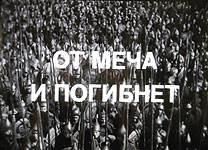 Just in case anyone could possibly have missed its political imperative up to this point, the celebration fades out in mid-phrase and Alexander delivers a deadly-serious speech directly to the camera: "Go tell everyone abroad that Russia lives and that anyone can visit her without fear. But he who comes with a sword dies by the sword. On this Russia stands and will stand forever!" The final two sentences are then repeated, phrase by phrase, in huge block letters over a shot of Alexander's armored soldiers clamoring for battle.
Just in case anyone could possibly have missed its political imperative up to this point, the celebration fades out in mid-phrase and Alexander delivers a deadly-serious speech directly to the camera: "Go tell everyone abroad that Russia lives and that anyone can visit her without fear. But he who comes with a sword dies by the sword. On this Russia stands and will stand forever!" The final two sentences are then repeated, phrase by phrase, in huge block letters over a shot of Alexander's armored soldiers clamoring for battle.
Alexander Nevsky clearly was intended as propaganda. Yet it remains a powerful experience that can be accepted on its own terms – a compelling mix of art and ardor. Indeed, even if you've never seen the movie (or have no desire to do so) the cantata ranks among the greatest of program music by effectively conjuring apposite imagery.
![]() Eisenstein and Prokofiev would collaborate once more on Ivan the Terrible (as it is known in English, although apparently a better translation would be "Ivan the Fearsome"), planned as a mammoth three-part historical epic to resurrect the glory of another past leader of Russia's formation, this time the 16th century czar who unified the realm of regional principalities into a vast empire. By the time he began Part One (1942-44) Eisenstein's esthetic had changed radically, eschewing his bold and innovative visceral montage for a leisurely succession of stunningly powerful images, constructing his film not through the collision of individual shots but with striking organic compositions that contain their own layers of meaning and generate their own cumulative emotional overtones.
Eisenstein and Prokofiev would collaborate once more on Ivan the Terrible (as it is known in English, although apparently a better translation would be "Ivan the Fearsome"), planned as a mammoth three-part historical epic to resurrect the glory of another past leader of Russia's formation, this time the 16th century czar who unified the realm of regional principalities into a vast empire. By the time he began Part One (1942-44) Eisenstein's esthetic had changed radically, eschewing his bold and innovative visceral montage for a leisurely succession of stunningly powerful images, constructing his film not through the collision of individual shots but with striking organic compositions that contain their own layers of meaning and generate their own cumulative emotional overtones. 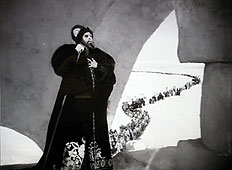
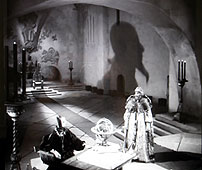 Consider these two – in the first, the ambition of Ivan, contemplating a globe of the world, literally overshadows his advisor, and in the second a seemingly endless stream of people beseech Ivan, confronting his jagged emotion in self-exile, to come to their rescue. In keeping with Eisenstein's altered visual style Prokofiev's score tends to support and correspond with the images rather than challenge or modify them and seems more conventional than for Nevsky, with the striking exception of a galvanizing fanfare that energizes the opening titles and close of each part by brilliantly encapsulating Ivan's mesmeric personality. Yet, the comparison is unfair, as Prokofiev never refined his Ivan soundtrack contributions into a focused concert suite. While others have tried to rise to that task, the results seem diffuse and largely unexceptional. Even so, Part One of the movie unfolds with constant fascination and its ending, even for those of us who don't readily identify with a ruthless Russian autocrat, is enormously potent as Ivan, crushed and despondent after the murder of his wife, answers the call of his people.
Consider these two – in the first, the ambition of Ivan, contemplating a globe of the world, literally overshadows his advisor, and in the second a seemingly endless stream of people beseech Ivan, confronting his jagged emotion in self-exile, to come to their rescue. In keeping with Eisenstein's altered visual style Prokofiev's score tends to support and correspond with the images rather than challenge or modify them and seems more conventional than for Nevsky, with the striking exception of a galvanizing fanfare that energizes the opening titles and close of each part by brilliantly encapsulating Ivan's mesmeric personality. Yet, the comparison is unfair, as Prokofiev never refined his Ivan soundtrack contributions into a focused concert suite. While others have tried to rise to that task, the results seem diffuse and largely unexceptional. Even so, Part One of the movie unfolds with constant fascination and its ending, even for those of us who don't readily identify with a ruthless Russian autocrat, is enormously potent as Ivan, crushed and despondent after the murder of his wife, answers the call of his people.
Part One of Ivan was showered with honors, no doubt in part to bolster morale during the bitter close of the War. Stalin praised Prokofiev's music and awarded Eisenstein the prestigious Order of Lenin, thus insulating both artists from purges, albeit only provisionally. Although completed in 1946 (and extending Eisenstein's theories into the realm of color), Part Two was not released until 1958, as it was banned by Stalin, who closely identified with the historical Ivan and rejected the portrayal of his hero as psychotic and obsessed with retribution (and who reportedly perceived parallels between the movie's harsh depiction of Ivan's armed guard and his own secret police). Plans to complete the trilogy were cancelled and all preliminary work for Part Three was destroyed. Eisenstein died in 1948. That same year Prokofiev was denounced by the Party's cultural gatekeepers as producing art alien to the artistic taste of the Soviet people and relegated the remaining five years of his life to "pallid scores of artistic inconsequence" (Schonberg).
![]() As is my custom, I've tried to focus on recordings that strike me as having the greatest historical and stylistic significance. The headnotes list the conductor, orchestra, chorus and mezzo-soprano soloist (followed in parentheses by the year, label and format of initial release; and approximate timing in minutes). But first, here are two of special interest.
As is my custom, I've tried to focus on recordings that strike me as having the greatest historical and stylistic significance. The headnotes list the conductor, orchestra, chorus and mezzo-soprano soloist (followed in parentheses by the year, label and format of initial release; and approximate timing in minutes). But first, here are two of special interest.
- Yuri Temirkanov, St. Petersburg Philharmonic Orchestra and Choruses, Evgenia Gorohovskaya (1995, RCA Victor CD; 47' + 4' overture)
This is not the Alexander Nevsky cantata but rather a re-recording of the film score. 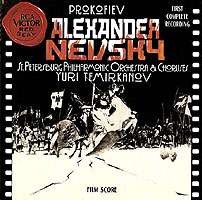 Producer John Goberman slams the original as a disaster: "Ironically, the best film score ever written is probably the worst soundtrack ever recorded." I wouldn't go that far – while it's true that some of the available prints are nth-generation dupes with miserable quality sound (and equally poor picture), others are decent. Yet unquestionable is the added power gained from improved sonic fidelity, full orchestration (which William Brohn arranged, modeled upon the instrumentation of the cantata) and well-trained professionals to upgrade the obsolete technology, scrappy studio band and mediocre playing heard on the original. This recording followed live performances accompanying showings of the movie (and was used on the soundtrack of a restored version of the movie that appears to have been issued only on lasardisc and videotape.) It "cheats" a bit by adding an overture (derived from the somber aftermath of the battle that appears only in the cantata) in order to accompany the opening movie credits (which Goberman terms "endless" although their stark appearance over full silence does create an atmosphere of tense expectation). In addition, it omits passages comprising fanfares, clanging bells and the bare percussion of the ice-breaking that were needed to accompany the film in the live performances but would have seemed adrift on record. It also combines into one music from parts of the same sequence (such as the two verses of the "Song About Alexander Nevsky"). Intrinsic merit aside, Goberman raises an intriguing point – the soundtrack for three shots depicting the invaders being blessed in their camp prior to the battle accompanies their hymn with a bare piano rather than the field organ that is shown and otherwise heard, leading Goberman to suspect that it was temporarily inserted as a patch for editing purposes, perhaps even as part of the rough cut hurriedly assembled for the Stalin preview and then frozen for posterity. That, in turn, raises a question as to the extent to which the soundtrack, as released, should be regarded as an inviolable finished product or whether a certain degree of updating is suitable, if not required, to fully reflect the creators' intentions.
Producer John Goberman slams the original as a disaster: "Ironically, the best film score ever written is probably the worst soundtrack ever recorded." I wouldn't go that far – while it's true that some of the available prints are nth-generation dupes with miserable quality sound (and equally poor picture), others are decent. Yet unquestionable is the added power gained from improved sonic fidelity, full orchestration (which William Brohn arranged, modeled upon the instrumentation of the cantata) and well-trained professionals to upgrade the obsolete technology, scrappy studio band and mediocre playing heard on the original. This recording followed live performances accompanying showings of the movie (and was used on the soundtrack of a restored version of the movie that appears to have been issued only on lasardisc and videotape.) It "cheats" a bit by adding an overture (derived from the somber aftermath of the battle that appears only in the cantata) in order to accompany the opening movie credits (which Goberman terms "endless" although their stark appearance over full silence does create an atmosphere of tense expectation). In addition, it omits passages comprising fanfares, clanging bells and the bare percussion of the ice-breaking that were needed to accompany the film in the live performances but would have seemed adrift on record. It also combines into one music from parts of the same sequence (such as the two verses of the "Song About Alexander Nevsky"). Intrinsic merit aside, Goberman raises an intriguing point – the soundtrack for three shots depicting the invaders being blessed in their camp prior to the battle accompanies their hymn with a bare piano rather than the field organ that is shown and otherwise heard, leading Goberman to suspect that it was temporarily inserted as a patch for editing purposes, perhaps even as part of the rough cut hurriedly assembled for the Stalin preview and then frozen for posterity. That, in turn, raises a question as to the extent to which the soundtrack, as released, should be regarded as an inviolable finished product or whether a certain degree of updating is suitable, if not required, to fully reflect the creators' intentions.
- Frank Strobel, Rundfunk-Sinfonieorchester Berlin, Ernest-Senff Chor, Maria Domeschenko (2004, Capriccio SACD; 56')
This second attempt to restore the soundtrack in credible sound and performance 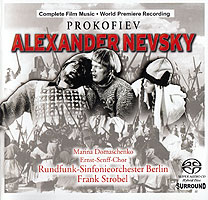 benefited from the composer's previously unavailable manuscript and sketches rather than having to rely upon efforts to glean the original orchestration from the amorphous tone of the soundtrack (or to ignore it altogether in favor of the fuller adaptation of the cantata). As a result, the producers assert that they could present the original instrumentation, dynamics and articulation with relative confidence. Indeed, they note that the keys specified in the score and heard on the film often differ and suspect that the playback speed of the original soundtrack recording was altered to fit the timing of the images, with a resultant change in pitch. They further note the experimental techniques used for the original recording, including "false orchestration" of adjusting the orchestra seating relative to the microphone to enhance the presence of soft instruments and shift the dominant ones to the background, and recording the orchestra and chorus in different rooms to achieve a degree of rudimentary mixing so as to vary their volumes, all of which was obviated by subsequently improved technology. Somewhat curiously, annoying flutter tones are substituted in lieu of directly emulating the deliberate distortion of the invaders' brass music. The tempos are nearly identical to Temirkanov's; rather, the substantially longer overall timing here stems from the inclusion of brief shards of relatively tedious music – fanfares, chiming bells, the ice-breaking percussion – that the earlier recording sensibly omitted. Yet to ears accustomed to the rich scoring of the cantata (from which the Temirkanov recording derived its orchestration), the outcome of Strobel's adherence to the original film instrumentation sounds thin and rather bland, albeit far better performed and captured than on the soundtrack. That, in turn, adds a further dimension to the underlying question of authenticity – did Prokofiev record the soundtrack with depleted forces that robbed it of much of its inherent power out of intention or necessity, and should the inherent limitations of the original be respected and preserved as an essential part of the artistic impression, or does the intrinsic intensity of the music justify, if not demand, that it be presented with all the resources and vitality that modern technology and a full orchestra and chorus can muster? (That's hardly a novel consideration, as it is routinely invoked in the on-going historical performance debates over whether the full glory of Bach, for example, is revealed on a harpsichord vs. a grand piano, baroque vs. cathedral organ, etc.)
benefited from the composer's previously unavailable manuscript and sketches rather than having to rely upon efforts to glean the original orchestration from the amorphous tone of the soundtrack (or to ignore it altogether in favor of the fuller adaptation of the cantata). As a result, the producers assert that they could present the original instrumentation, dynamics and articulation with relative confidence. Indeed, they note that the keys specified in the score and heard on the film often differ and suspect that the playback speed of the original soundtrack recording was altered to fit the timing of the images, with a resultant change in pitch. They further note the experimental techniques used for the original recording, including "false orchestration" of adjusting the orchestra seating relative to the microphone to enhance the presence of soft instruments and shift the dominant ones to the background, and recording the orchestra and chorus in different rooms to achieve a degree of rudimentary mixing so as to vary their volumes, all of which was obviated by subsequently improved technology. Somewhat curiously, annoying flutter tones are substituted in lieu of directly emulating the deliberate distortion of the invaders' brass music. The tempos are nearly identical to Temirkanov's; rather, the substantially longer overall timing here stems from the inclusion of brief shards of relatively tedious music – fanfares, chiming bells, the ice-breaking percussion – that the earlier recording sensibly omitted. Yet to ears accustomed to the rich scoring of the cantata (from which the Temirkanov recording derived its orchestration), the outcome of Strobel's adherence to the original film instrumentation sounds thin and rather bland, albeit far better performed and captured than on the soundtrack. That, in turn, adds a further dimension to the underlying question of authenticity – did Prokofiev record the soundtrack with depleted forces that robbed it of much of its inherent power out of intention or necessity, and should the inherent limitations of the original be respected and preserved as an essential part of the artistic impression, or does the intrinsic intensity of the music justify, if not demand, that it be presented with all the resources and vitality that modern technology and a full orchestra and chorus can muster? (That's hardly a novel consideration, as it is routinely invoked in the on-going historical performance debates over whether the full glory of Bach, for example, is revealed on a harpsichord vs. a grand piano, baroque vs. cathedral organ, etc.)
Both the Temirkanov and Strobel ventures raise a qualm of why anyone would want to hear all the soundtrack cues, which are functional in the context of the film and specifically were designed for that purpose but in isolation sound incoherent, fragmented and without any apparent logical order – indeed, randomly reordering the 27 cuts on the Strobel CD through "shuffle play" hardly seems to matter. Yet, when heard divorced from the film they do serve a constructive function of sorts – to enhance appreciation for the skill with which Prokofiev adapted these materials into his cantata. Speaking of which ...
- Leopold Stokowski, NBC Symphony Orchestra, Westminster College Choir, Jennie Tourel (March 7, 1943, various on-line sources; 37')
- Leopold Stokowski, Netherlands Radio Philharmonic Orchestra, Groot Omroepchor, Sophia van Sante (August 22, 1970, Music and Arts or Medici CD; 36')
Toscanini and Stokowski feuded over the American premiere of Shostakovich's 1942 Symphony # 7,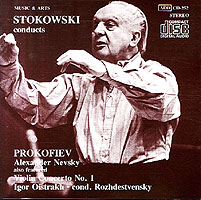 written in tribute to Russian resistance to the siege of Leningrad. Toscanini won, but Stokowski got an even better consolation prize – the Western premiere of the vastly superior Alexander Nevsky, which he broadcast as a guest conductor over the NBC radio network with the NBC Symphony (Toscanini's orchestra!) on March 7, 1943. Even if both gestures arose from a sense of patriotic duty toward a then-ally (Toscanini later called the Shostakovich symphony "junk"), the Stokowski concert remains a fine experience, preserved in surprisingly decent sound that conveys a significant degree of texture but that also launched a practice that would become prevalent of singing the Russian lyrics in English translation (except for the invaders' hymn that remains in the scornful Latin), although the words do fit the music and, rather remarkably for choral recordings of that vintage, are somewhat intelligible. Perhaps as a nod to the need to suit AM broadcast technology, much of the percussion is either omitted or so attenuated as to be barely audible. We also have a 1970 Dutch television concert in excellent stereo that preserves the full scope of the sonic splendor for which Stokowski was famed and provides a fascinating comparison to the premiere (and is sung in Russian). While the 1943 broadcast has plenty of impact, the 1970 concert adds extra boldness – perhaps no longer feeling constrained by the responsibility of introducing a new work, Stokowski melds the separate movements into an uninterrupted organic flow, while letting out all the stops to craft an intensely dramatic experience full of broad gestures. At the very outset he voices the opening chords crisply and then halves the tempo for the plangent atmospheric woodwinds and never lets up, from the rushed pace of the German hymn in the third movement that creates a frightening contrast with the cowering strings of the victims, to beginning the invaders' battle charge at a crawl that accelerates into a wild, seemingly unstoppable force that the Russian theme, tinged with caution, can only hope to overcome with dogged will-power and indeed only gradually acquires an edge of victory. Together the two Stokowski concerts document a conductor who was an unabashed intrepid venturer.
written in tribute to Russian resistance to the siege of Leningrad. Toscanini won, but Stokowski got an even better consolation prize – the Western premiere of the vastly superior Alexander Nevsky, which he broadcast as a guest conductor over the NBC radio network with the NBC Symphony (Toscanini's orchestra!) on March 7, 1943. Even if both gestures arose from a sense of patriotic duty toward a then-ally (Toscanini later called the Shostakovich symphony "junk"), the Stokowski concert remains a fine experience, preserved in surprisingly decent sound that conveys a significant degree of texture but that also launched a practice that would become prevalent of singing the Russian lyrics in English translation (except for the invaders' hymn that remains in the scornful Latin), although the words do fit the music and, rather remarkably for choral recordings of that vintage, are somewhat intelligible. Perhaps as a nod to the need to suit AM broadcast technology, much of the percussion is either omitted or so attenuated as to be barely audible. We also have a 1970 Dutch television concert in excellent stereo that preserves the full scope of the sonic splendor for which Stokowski was famed and provides a fascinating comparison to the premiere (and is sung in Russian). While the 1943 broadcast has plenty of impact, the 1970 concert adds extra boldness – perhaps no longer feeling constrained by the responsibility of introducing a new work, Stokowski melds the separate movements into an uninterrupted organic flow, while letting out all the stops to craft an intensely dramatic experience full of broad gestures. At the very outset he voices the opening chords crisply and then halves the tempo for the plangent atmospheric woodwinds and never lets up, from the rushed pace of the German hymn in the third movement that creates a frightening contrast with the cowering strings of the victims, to beginning the invaders' battle charge at a crawl that accelerates into a wild, seemingly unstoppable force that the Russian theme, tinged with caution, can only hope to overcome with dogged will-power and indeed only gradually acquires an edge of victory. Together the two Stokowski concerts document a conductor who was an unabashed intrepid venturer.
- Eugene Ormandy, Philadelphia Orchestra, Westminster Choir, Jennie Tourel (1945, Columbia 78s; 36½')
Although he served as Stokowski's assistant, Ormandy had a contrary artistic temperament. 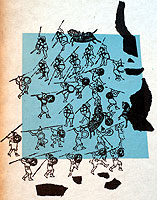

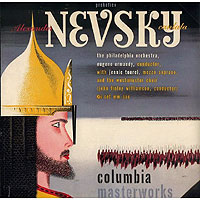 Throughout his remarkable 44-year tenure heading the Philadelphia Orchestra, Ormandy was known for reliable excellence and thorough polishing, but perhaps it was his muted personality and an inability to categorize his talent that led critics to relegate him to secondary status. Yet the famed lustrous tone of his orchestra was both intrinsically fascinating and thoroughly convincing in most repertoire, including the Russian moderns on whom he doted, leading the first recordings of Prokofiev's Sixth (1950 – sensational), and Seventh Symphonies. And that's what we hear in this first Nevsky studio recording – smooth, level dynamics, attenuated percussion and blended sonorities more suited to plastic modeling of the softer passages than the battle, which could use a bit more oomph. The difference with Stokowski perhaps suggests that replicating the objective bearing of the soundtrack might not suffice without the visuals and that the music standing alone in a concert or recording needs some highlighting to sustain interest. In any event, Ormandy provides a good baseline for subsequent studio recordings, introducing the music rather objectively and leaving others to embellish. A side note – long before his pop art fame, Andy Warhol was a commercial illustrator and provided the cover graphic for the transfer of this recording to Columbia's new LP format. Using his "blotted line" technique of transferring a heavily-inked sketch to absorbent paper, the result was issued in four variants using different solid background colors of blue, green, orange and pink. Even the most common blue copies command a hundred dollars or more from collectors nowadays, the package being worth far more than the content. And speaking of cost, let's not forget that the original album of five 78s cost $5.50 (equivalent to about $75 as of 2015). And we complain about current music prices! Following the lapse of their long-term Columbia contract, Ormandy and the Philadelphians re-recorded Nevsky for their new label, RCA, in 1975 – considerably more emphatic, as if to shun the objectivity of their pioneering endeavor.
Throughout his remarkable 44-year tenure heading the Philadelphia Orchestra, Ormandy was known for reliable excellence and thorough polishing, but perhaps it was his muted personality and an inability to categorize his talent that led critics to relegate him to secondary status. Yet the famed lustrous tone of his orchestra was both intrinsically fascinating and thoroughly convincing in most repertoire, including the Russian moderns on whom he doted, leading the first recordings of Prokofiev's Sixth (1950 – sensational), and Seventh Symphonies. And that's what we hear in this first Nevsky studio recording – smooth, level dynamics, attenuated percussion and blended sonorities more suited to plastic modeling of the softer passages than the battle, which could use a bit more oomph. The difference with Stokowski perhaps suggests that replicating the objective bearing of the soundtrack might not suffice without the visuals and that the music standing alone in a concert or recording needs some highlighting to sustain interest. In any event, Ormandy provides a good baseline for subsequent studio recordings, introducing the music rather objectively and leaving others to embellish. A side note – long before his pop art fame, Andy Warhol was a commercial illustrator and provided the cover graphic for the transfer of this recording to Columbia's new LP format. Using his "blotted line" technique of transferring a heavily-inked sketch to absorbent paper, the result was issued in four variants using different solid background colors of blue, green, orange and pink. Even the most common blue copies command a hundred dollars or more from collectors nowadays, the package being worth far more than the content. And speaking of cost, let's not forget that the original album of five 78s cost $5.50 (equivalent to about $75 as of 2015). And we complain about current music prices! Following the lapse of their long-term Columbia contract, Ormandy and the Philadelphians re-recorded Nevsky for their new label, RCA, in 1975 – considerably more emphatic, as if to shun the objectivity of their pioneering endeavor.
- Samuel Samosud, Russian State Radio Orchestra and Chorus, Ludmilla Legostayeva (1947, Melodiya and numerous other labels, 41½')
This first Russian recording of Nevsky boasts unique authenticity,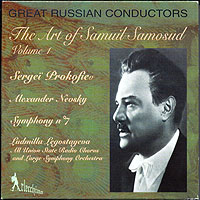 as it bears the imprimatur of a conductor who championed Prokofiev, whom the composer consulted on his late operas, and whom he considered the preeminent interpreter of his work. Although Prokofiev himself led the first performance of his Nevsky cantata in May 1939, we have only a single authenticated recording of his own conducting – the half-hour second suite from his Romeo and Juliet ballet, cut with the Moscow Philharmonic in 1938 (now on a Parnassus CD). If it's fair to judge from that sole example, his approach is thick and deliberate with little grace or humor, even in the sections depicting youth and dancing – a far cry from his dynamic 1935 set of solo piano recordings and his spirited 1932 Piano Concerto # 3 with Coppola and the London Symphony. Not surprisingly, Samosud largely follows suit with Nevsky (although that score hardly calls for the light touch of a ballet). As is evident from the overall timing, Samosud's tempos are considerably slower than the norm, yet they generally follow Prokofiev's specifications in the score and as a result deepen the impact, from the opening that forebodes profound tragedy to the finale that tinges victory with reflective regret for its cost. In lieu of the central portion of the "Song for Alexander" that often tends to gallop away, his pacing is only slightly faster, reflecting the score's indication of a mere "più mosso" rather than a wholly new tempo, and "Arise Ye Russian People" gains a greater sense of religious conviction. The choral singing of the Russian songs is fervent and severe, as if every syllable counts, and rises above the accompaniment to emphasize its import, while the German hymns are blurred, dull and thick, and often sink beneath the instruments (although the tempo accelerates and the balance shifts at the end of the "Crusaders in Pskov" to signify a real threat materializing). The "Battle on the Ice" proceeds patiently and methodically (with a near complete absence of percussion) to emphasize the difficulty of the struggle. The "Field of the Dead" begins considerably faster than the score indication, but ignores tempo changes to paint a picture of unwavering resilience and gradually slows as if in utter exhaustion. Overall, when drained of visceral excitement, the intensity of the score emerges from within, emphasizing determination and sacrifice over any notion of an ecstatic victory.
as it bears the imprimatur of a conductor who championed Prokofiev, whom the composer consulted on his late operas, and whom he considered the preeminent interpreter of his work. Although Prokofiev himself led the first performance of his Nevsky cantata in May 1939, we have only a single authenticated recording of his own conducting – the half-hour second suite from his Romeo and Juliet ballet, cut with the Moscow Philharmonic in 1938 (now on a Parnassus CD). If it's fair to judge from that sole example, his approach is thick and deliberate with little grace or humor, even in the sections depicting youth and dancing – a far cry from his dynamic 1935 set of solo piano recordings and his spirited 1932 Piano Concerto # 3 with Coppola and the London Symphony. Not surprisingly, Samosud largely follows suit with Nevsky (although that score hardly calls for the light touch of a ballet). As is evident from the overall timing, Samosud's tempos are considerably slower than the norm, yet they generally follow Prokofiev's specifications in the score and as a result deepen the impact, from the opening that forebodes profound tragedy to the finale that tinges victory with reflective regret for its cost. In lieu of the central portion of the "Song for Alexander" that often tends to gallop away, his pacing is only slightly faster, reflecting the score's indication of a mere "più mosso" rather than a wholly new tempo, and "Arise Ye Russian People" gains a greater sense of religious conviction. The choral singing of the Russian songs is fervent and severe, as if every syllable counts, and rises above the accompaniment to emphasize its import, while the German hymns are blurred, dull and thick, and often sink beneath the instruments (although the tempo accelerates and the balance shifts at the end of the "Crusaders in Pskov" to signify a real threat materializing). The "Battle on the Ice" proceeds patiently and methodically (with a near complete absence of percussion) to emphasize the difficulty of the struggle. The "Field of the Dead" begins considerably faster than the score indication, but ignores tempo changes to paint a picture of unwavering resilience and gradually slows as if in utter exhaustion. Overall, when drained of visceral excitement, the intensity of the score emerges from within, emphasizing determination and sacrifice over any notion of an ecstatic victory.
- Mario Rossi, Vienna State Opera Orchestra and Chorus, Ana Maria Iriarte (1954, Vanguard LP; 36')
Although signed by Vanguard in early 1954 to expand their classical catalog,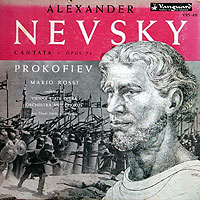 Rossi was primarily an opera conductor known more for competence than inspiration. Even so, he led a splendid 1962 Lt. Kije full of subtle characterization (also with the Vienna State Opera Orchestra, the farm team for the Vienna Philharmonic), but in comparison his Nevsky is rather disappointing. Despite his background, the singing is bland and the vocal forces sound thin and undernourished, with individual voices occasionally coming to the forefront. The Russians and Germans sound equally dutiful, conveying neither pride nor threat. The sound is congested, with violins and piccolos hard to distinguish in the battle introduction. The battle itself comes across as tedious abstract music with little sense of the narrative drama, plagued with indifferent playing and haphazard singing, only partly redeemed by prominent percussion and some dramatic tempo changes, although balances can be illogically skewed, as when the Russian theme of triumph is suffocated beneath its accompaniment, even though the stillness of the aftermath is presented rather effectively. Perhaps the most impressive movement is the fourth in which the singing is relatively enthused, energized by quick pacing and spiced by prominent xylophone and cymbals (although the latter sound like garbage can lids).
Rossi was primarily an opera conductor known more for competence than inspiration. Even so, he led a splendid 1962 Lt. Kije full of subtle characterization (also with the Vienna State Opera Orchestra, the farm team for the Vienna Philharmonic), but in comparison his Nevsky is rather disappointing. Despite his background, the singing is bland and the vocal forces sound thin and undernourished, with individual voices occasionally coming to the forefront. The Russians and Germans sound equally dutiful, conveying neither pride nor threat. The sound is congested, with violins and piccolos hard to distinguish in the battle introduction. The battle itself comes across as tedious abstract music with little sense of the narrative drama, plagued with indifferent playing and haphazard singing, only partly redeemed by prominent percussion and some dramatic tempo changes, although balances can be illogically skewed, as when the Russian theme of triumph is suffocated beneath its accompaniment, even though the stillness of the aftermath is presented rather effectively. Perhaps the most impressive movement is the fourth in which the singing is relatively enthused, energized by quick pacing and spiced by prominent xylophone and cymbals (although the latter sound like garbage can lids).
- Fritz Reiner, Chicago Symphony Orchestra and Chorus, Rosalind Elias (1959, RCA LP, 42')
Praised since its initial release, this was not only the first stereo Nevsky 
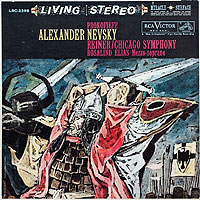 but the earliest recording to present the score in true high fidelity. It still impresses with a striking combination of rich sound and complex textures, underpinned by deep winds and flatulent brass in the bowels of the orchestra that reveal the full splendor and effectiveness of Prokofiev's disquieting mood-painting. Known as a strict technician and perfectionist, Reiner leads remarkably precise playing of dry, focused clarity, the atmosphere arising far more from the instrumental timbres than overt emotion or spirituality. Thus the quality of each note is distinctly heard at the very outset as the oboe and bass clarinet combine for a mesmerizing sonority by playing the same languid melody three octaves apart over 32nd note violin runs. On the other end of the dynamic spectrum, the battle conjures waves of sound to emulate the ebb and flow of protracted combat in which the separate instrumental and vocal strands can be clearly perceived and most of the text can be understood. Alas, that is a dubious benefit – the singing is in English, clumsily phrased ("Unseen the ways to Russia are") and with accents awkwardly placed to fit the notes. Indeed, while the lyrical intent was political and thus more suited to practical prose than aspiring to immortal poetry, the words seem so prosaic as to better remain in a language that defies most listeners' understanding, enabling us to imagine them to be far more inspiring than they are. The firm objectivity of Reiner's approach is invoked by the graphic that graced the entire back cover of the first LP release (labeled only as "Heroes" and "Ross '53"), although its monochrome fairly defies the recording's remarkable palette of textures that is better matched by the colorful painting on the front by Federico Castellon. The incongruous CD companion is a brilliant reading of the scintillating Khachaturian Violin Concerto by Leonid Kogan and the Boston Symphony under Monteux that, while superb, has little in common with Nevsky beyond the composers' nationality.
but the earliest recording to present the score in true high fidelity. It still impresses with a striking combination of rich sound and complex textures, underpinned by deep winds and flatulent brass in the bowels of the orchestra that reveal the full splendor and effectiveness of Prokofiev's disquieting mood-painting. Known as a strict technician and perfectionist, Reiner leads remarkably precise playing of dry, focused clarity, the atmosphere arising far more from the instrumental timbres than overt emotion or spirituality. Thus the quality of each note is distinctly heard at the very outset as the oboe and bass clarinet combine for a mesmerizing sonority by playing the same languid melody three octaves apart over 32nd note violin runs. On the other end of the dynamic spectrum, the battle conjures waves of sound to emulate the ebb and flow of protracted combat in which the separate instrumental and vocal strands can be clearly perceived and most of the text can be understood. Alas, that is a dubious benefit – the singing is in English, clumsily phrased ("Unseen the ways to Russia are") and with accents awkwardly placed to fit the notes. Indeed, while the lyrical intent was political and thus more suited to practical prose than aspiring to immortal poetry, the words seem so prosaic as to better remain in a language that defies most listeners' understanding, enabling us to imagine them to be far more inspiring than they are. The firm objectivity of Reiner's approach is invoked by the graphic that graced the entire back cover of the first LP release (labeled only as "Heroes" and "Ross '53"), although its monochrome fairly defies the recording's remarkable palette of textures that is better matched by the colorful painting on the front by Federico Castellon. The incongruous CD companion is a brilliant reading of the scintillating Khachaturian Violin Concerto by Leonid Kogan and the Boston Symphony under Monteux that, while superb, has little in common with Nevsky beyond the composers' nationality.
- Thomas Schippers, New York Philharmonic, Westminster Choir, Lili Chookasian (1962, Columbia LP; 42')
Rossi lived to 90, but Schippers, also famed for opera, died at 47,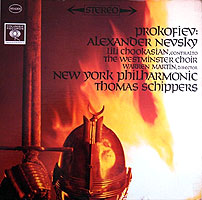 in the mere adolescence of a conductor's career. In its February 21, 1969 issue contemplating Leonard Bernstein's retirement as Music Director of the New York Philharmonic, Life magazine had dubbed Schippers the "heir apparent ... now virtually number two at the Philharmonic and foremost among a galaxy of young American conductors." (He lost out to Pierre Boulez and spent what little remained of his career in Cincinnati.) While Life cited his "total involvement ... There is a lot of theater in Schippers, who allows that he is more emotional than intellectual," his few studio recordings are mostly tender, warm and polished – and very slow-paced (including 1957 Philharmonia Prokofiev Fifth and Tchaikovsky Fourth Symphonies for EMI and a Schubert Unfinished that runs 26 minutes without repeats). (But just to show the danger of relying on overly-simplistic generalizations in art, a 1965 Tchaikovsky Violin Concerto with Zino Francescatti is atypically impulsive and a 1965 program of Barber, for whom he had a special affinity, is electrifying.) All the wonder, then, that his Nevsky not only is outstandingly vital throughout but that he got to record it at all with the Philharmonic with which he was associated throughout the 'sixties but was given few recording opportunities – Columbia clearly preferred to market its superstar Bernstein, for whom Nevsky seemingly would have been an ideal vehicle. In any event, both orchestra and chorus play for Schippers with tangible enthusiasm, conveying contagious conviction (but ample serenity as well, as in the calm central portion of "Arise"), and sharp emphases that heighten the impact with clashes of treble textures and bright, crisp, detailed fidelity that belie the overall deliberate tempos – even the bass drum stands out with a crisp thwack rather than a dull thud. The Russian songs, in particular, leap with heartfelt, unrestrained ardor, and the battle startles with huge dynamic contrasts. This is a fresh, invigorating, youthful view of the piece that reflects the revolutionary ardor that inspired it.
in the mere adolescence of a conductor's career. In its February 21, 1969 issue contemplating Leonard Bernstein's retirement as Music Director of the New York Philharmonic, Life magazine had dubbed Schippers the "heir apparent ... now virtually number two at the Philharmonic and foremost among a galaxy of young American conductors." (He lost out to Pierre Boulez and spent what little remained of his career in Cincinnati.) While Life cited his "total involvement ... There is a lot of theater in Schippers, who allows that he is more emotional than intellectual," his few studio recordings are mostly tender, warm and polished – and very slow-paced (including 1957 Philharmonia Prokofiev Fifth and Tchaikovsky Fourth Symphonies for EMI and a Schubert Unfinished that runs 26 minutes without repeats). (But just to show the danger of relying on overly-simplistic generalizations in art, a 1965 Tchaikovsky Violin Concerto with Zino Francescatti is atypically impulsive and a 1965 program of Barber, for whom he had a special affinity, is electrifying.) All the wonder, then, that his Nevsky not only is outstandingly vital throughout but that he got to record it at all with the Philharmonic with which he was associated throughout the 'sixties but was given few recording opportunities – Columbia clearly preferred to market its superstar Bernstein, for whom Nevsky seemingly would have been an ideal vehicle. In any event, both orchestra and chorus play for Schippers with tangible enthusiasm, conveying contagious conviction (but ample serenity as well, as in the calm central portion of "Arise"), and sharp emphases that heighten the impact with clashes of treble textures and bright, crisp, detailed fidelity that belie the overall deliberate tempos – even the bass drum stands out with a crisp thwack rather than a dull thud. The Russian songs, in particular, leap with heartfelt, unrestrained ardor, and the battle startles with huge dynamic contrasts. This is a fresh, invigorating, youthful view of the piece that reflects the revolutionary ardor that inspired it.
- Karel Ancerl, Czech Philharmonic, Prague Philharmonic Choir, Vera Soukupova (1962, Supraphon LP, 38½')
It's often risky – and speculative – to ascribe political motives to interpretations of classical music,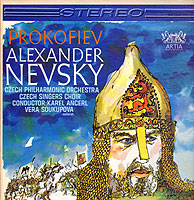 but here it just might be warranted. Although Ancerl's life began in privilege, it radically departed from the typical pampered course for a conductor. The sole member of his family to survive Auschwitz, his 18 years of devoted service leading the Czech Philharmonic were repaid with exile upon the Soviet occupation. It's hardly a stretch to assume that his punishing personal experiences led to an aversion to war and politics that informed his approach to Alexander Nevsky. Thus the German hymn sounds bitter, harsh and downright ugly and the Russian rallying song ("Arise ...") is largely drained of enthusiasm and smothered by cymbals. Indeed, the dramatic movements focus far more on lulls and suffering than aggression or triumph and the finale musters more energy for the peoples' central portion than the victors' conclusion that is made to sound trite and childish with an exaggerated xylophone. The impression is magnified by the harsh, wiry recording that tends to falsify the famed sound of the Czech Philharmonic's deep, warm reverberant strings and precisely-focused winds; indeed, its mellow brass come across as uncharacteristically sharp, nagging and hostile. We know from his many other recordings that Ancerl could lead with folksy charm and devoted focus but here I have to wonder if he regarded both Germans and Russians with equal contempt and could have cared less about the political outcome of their 13th century battle, even while fully empathizing with the hardships of the populace. His recording reaches its emotional peak in "The Field for the Dead," an immensely moving elegy for past losses and, by implication, a heartfelt prayer for future sanity.
but here it just might be warranted. Although Ancerl's life began in privilege, it radically departed from the typical pampered course for a conductor. The sole member of his family to survive Auschwitz, his 18 years of devoted service leading the Czech Philharmonic were repaid with exile upon the Soviet occupation. It's hardly a stretch to assume that his punishing personal experiences led to an aversion to war and politics that informed his approach to Alexander Nevsky. Thus the German hymn sounds bitter, harsh and downright ugly and the Russian rallying song ("Arise ...") is largely drained of enthusiasm and smothered by cymbals. Indeed, the dramatic movements focus far more on lulls and suffering than aggression or triumph and the finale musters more energy for the peoples' central portion than the victors' conclusion that is made to sound trite and childish with an exaggerated xylophone. The impression is magnified by the harsh, wiry recording that tends to falsify the famed sound of the Czech Philharmonic's deep, warm reverberant strings and precisely-focused winds; indeed, its mellow brass come across as uncharacteristically sharp, nagging and hostile. We know from his many other recordings that Ancerl could lead with folksy charm and devoted focus but here I have to wonder if he regarded both Germans and Russians with equal contempt and could have cared less about the political outcome of their 13th century battle, even while fully empathizing with the hardships of the populace. His recording reaches its emotional peak in "The Field for the Dead," an immensely moving elegy for past losses and, by implication, a heartfelt prayer for future sanity.
- Yevgeny Svetlanov, USSR Symphony Orchestra, RSFSR Russian Chorus, L. Andreyeva (1966, Melodiya LP, 38')
Heard here at the start of his remarkable 35-year tenure with the USSR Symphony Orchestra,  Svetlanov to many represented the quintessence of Russian music and the envoy of its heritage, devoting especial service to more obscure composers (of whom he was one), including the 27 symphonies of Prokofiev's student and friend Nikolai Miaskovsky. In that light, his Nevsky can be considered along with Samosov's as the Russian view, presenting the score persuasively, conveying its logic, each element in place without exaggeration or flashiness. Indeed it seems to sound "right." (Alas – echoing Eisenstein and Prokofiev's friction with the authorities – Svetlanov was summarily dismissed from his orchestra in 2000, ostensibly for having spent too much time abroad). The stereo spread is extreme and the dynamic range is wide, dropping the soft portions to whispers, although the "Field of the Dead" solo consistently dwells above the piano volume to which the score generally adheres, and he does add a dramatic pause before the first appearance of the Russian theme in the battle, perhaps unable to resist stressing its thematic significance. (A Svetlanov 1988 Philharmonia concert [ICA Classics CD] seems more generic.) Overall, this is an essentially Russian recording in modern sound.
Svetlanov to many represented the quintessence of Russian music and the envoy of its heritage, devoting especial service to more obscure composers (of whom he was one), including the 27 symphonies of Prokofiev's student and friend Nikolai Miaskovsky. In that light, his Nevsky can be considered along with Samosov's as the Russian view, presenting the score persuasively, conveying its logic, each element in place without exaggeration or flashiness. Indeed it seems to sound "right." (Alas – echoing Eisenstein and Prokofiev's friction with the authorities – Svetlanov was summarily dismissed from his orchestra in 2000, ostensibly for having spent too much time abroad). The stereo spread is extreme and the dynamic range is wide, dropping the soft portions to whispers, although the "Field of the Dead" solo consistently dwells above the piano volume to which the score generally adheres, and he does add a dramatic pause before the first appearance of the Russian theme in the battle, perhaps unable to resist stressing its thematic significance. (A Svetlanov 1988 Philharmonia concert [ICA Classics CD] seems more generic.) Overall, this is an essentially Russian recording in modern sound.
Svetlanov's CD filler is the rarely-heard Zdravitsa ("Festival Song"), a cantata which Prokofiev wrote in 1939 to celebrate Stalin's 60th birthday, presumably as insurance to stay in the leader's good graces (and indeed he would later cite it in his defense during the 1948 purge). The text was prescribed by a committee and, as Vladimir Orlov describes it, enforces the "cultural myth" of Stalin as Father of Nations through a prism of gratitude of various ethnicities whose unity in the Russian nation Stalin maintained (albeit not always willingly), and praises the splendor of life under his rule, culminating in a compelling C-major apotheosis. Lush, melodic and thoroughly undemanding, Zdravitsa puts into perspective any temptation to disparage Alexander Nevsky as mere propaganda – this is the real thing.
- André Previn, London Symphony Orchestra and Chorus, Anna Reynolds (1972, EMI/Angel LP, 42')
- Claudio Abbado, London Symphony Orchestra and Chorus, Elena Obraztsova (1880, DG LP, 38½')
- Neeme Jarvi, Scottish National Orchestra, SNO Chorus, Linda Finne (1988, Chandos CD, 40')
- Valery Gergiev, Mariinsky (Kirov) Orchestra and Chorus, Olga Borodina (2002, Philips CD, 35½')
There have been many further recordings of Nevsky
 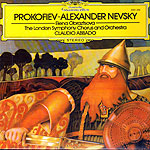   |
![]() As always, I accept credit and blame for the musical judgments but gratefully acknowledge the following sources for the facts and citations in this article:
As always, I accept credit and blame for the musical judgments but gratefully acknowledge the following sources for the facts and citations in this article:
- Atfelder, Paul: notes to the Ormandy LP (Columbia ML 4247, c. 1949)
- Barlow, Harold: Selected Letters of Sergei Prokofiev (Northeastern University, 1998)
- Cole, Edward: notes to the Ancerl LP (Artia ALS-7202, c. 1962)
- Cooke, Mervyn: A History of Film Music (Cambridge University, 2008)
- Downes, Edward: notes to the Schippers LP (Columbia MS 6306, 1962)
- Eisenstein, Sergei: Notes of a Film Director (tr: X. Danko; Dover, 1970)
- Eisenstein, Sergei: The Film Sense (tr. and ed.: Jay Leyda; Faber & Faber, 1943)
- Gammond, Peter: notes to the Previn LP (Angel 36483, 1972)
- Glosar, Nina and Frank Strobel: notes to the Strobel CD (Capriccio SACD 71014, 2004)
- Goberman, John: notes to the Temirkanov CD (RCA 09026 61926-2, 1994)
- Goodwin, James: Eisenstein, Film and History (University of Illinois, 1993)
- Leyda, Jay: Kino (Collier, 1969)
- Mast, Gerald: A Short History of the Movies (Pegasus, 1971)
- Orlov, Vladimir: "Prokofiev and the Myth of the Father of Nations – The Cantata Zdravitsa" (Journal of Musicology 30:4, University of California, 2013)
- Perkins, V. F.: Film as Film (Penguin, 1972)
- Pudovkin: On Film Technique (tr: Ivor Montegu; Vision Press, 1950)
- Robinson, Harlow: Sergei Prokofiev – A Biography (Viking, 1987)
- Schonberg, Harold: Lives of the Great Composers (Norton, 1981)
- Smith, Tim J.: "Audiovisual Correspondences in Sergei Eisenstein's Alexander Nevsky: A Case Study in Viewer Attention" in Ted Nannicelli and Paul Taberham: Cognitive Media Theory (Routledge, 2014)
In addition, all the movies mentioned are on YouTube in prints of varying quality: Feinzimmer's Lieutenant Kije and Eisenstein's Strike, Battleship Potemkin, October – Ten Days That Shook the World, Old and New [aka The General Line], Alexander Nevsky, Ivan the Terrible, Part 1 and Ivan the Terrible, Part 2.
![]()
Copyright 2015 by Peter Gutmann
copyright © 1998-2015 by Peter Gutmann. All rights reserved.